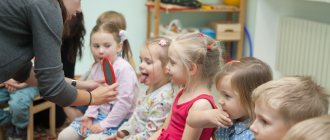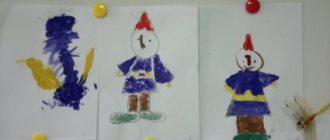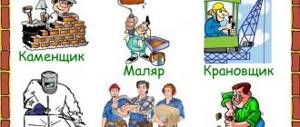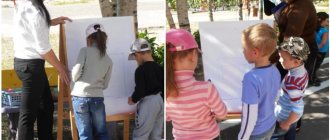Conducting an open lesson is an exciting moment in the life of a teacher. A teacher working with middle group children (4-5 years old) - little “whys” - is faced with the task of making the event memorable and interesting for the children and at the same time gaining the approval of colleagues and parents of the students. A well-thought-out lesson structure, a selection of literature, development of exercises, preparation of equipment - such carefully completed work will allow you to show yourself as a good professional and a person doing what you love.
- 1.1 Types of open classes in preschool educational institutions
1.1.1 Examples of open classes in the middle group, taking into account the age characteristics of pupils - 1.1.2 Video: open lesson on social-emotional development in the middle group
- 2 Conducting an open lesson in the middle group of a preschool educational institution
2.1 Table: plan for the teacher’s speech before an open lesson
- 2.2 List of topics for open classes for the middle group
- 2.3 Table: time plan for an open lesson in the middle group
- 2.4 Table: example of a summary of an open lesson in the middle group
Preparing an open lesson in the middle group of kindergarten
An open lesson is one of the forms of methodological work of an educational institution. The teacher conducting such a lesson demonstrates to his colleagues some new ideas or technologies in the educational field or shares his accumulated experience, illustrating it with the results achieved by the children. This could also be an event for parents of pupils in order to familiarize them with the features of the educational process in kindergarten and the successes of the children.
For preschoolers, this is a common activity that is part of the general planning of the group’s work and is intended to perform certain educational and educational tasks. Children come to class without any special preparation or preliminary “rehearsals.” Pupils of the middle group already know and can do a lot, their speech, intellectual abilities and emotional-volitional sphere are actively developing, positive changes are observed in the development of motor skills, and independence is manifested. When conducting an open lesson, the teacher should take into account the high mental activity of preschoolers of this age.
An open lesson should not differ from a regular lesson in its content and pace of activity.
Five-year-old “why girls” are interested in cause-and-effect relationships in different areas of life, they are fascinated by the professional activities of adults, and they begin to develop an idea of various aspects of the world around them.
Types of open classes in preschool educational institutions
According to their goals, open classes in the middle group can be of different types:
- Open lesson as part of the activities of the Ministry of Education of educational institutions. It can be carried out to train young specialists or as an exchange of experience between colleagues.
- Lesson for the certification commission before passing the exam for a higher qualification category.
- Lesson as part of participation in a professional competition.
- Open viewing for parents of pupils.
An open lesson for colleagues or the certification committee should show something new in the teaching process. This could be a new technology for teaching a lesson or a new technique in presenting material, selecting assignments, motivating children, organizing the workplace, etc.
An open lesson differs from a regular lesson in the presence of a methodological goal that reflects what the teacher wants to demonstrate to the observers present.
Examples of open classes in the middle group, taking into account the age characteristics of students
Open classes in the middle group can be conducted within various subject areas and using various equipment:
- Use of computer technology. An interactive whiteboard and computer significantly expand the capabilities of visual teaching methods, which at this age are basic due to the predominance of visual-figurative thinking in children. ICTs make it possible to present the object of study in a more holistic and colorful way. Preschoolers cannot help but be attracted by the brightness and expressiveness of the multimedia material shown. It should be borne in mind that the use of a large screen reduces the load on the vision of preschoolers, which is especially important since the lens of children’s eyes is in the process of formation. All of the above speaks in favor of conducting classes using computer technology. Kireeva Svetlana “Lesson notes using ICT “Hello, hedgehog!”
- Elena Zvonareva “Summary of an open lesson with middle group students using ICT and electronic educational resources.”
- Molyavchikova Olga “Pumpkin for Cinderella.”
Drawing can be a separate stage of an open lesson
- Yashkuzina Evgeniya “We will go to save Spring.”
- Vasilyeva Elena “Be healthy!”
- Valentin's cabin "Learning to be friends."
- Andrianova Olga “An interesting journey.”
- Afanasyeva Lyubov “On a visit to the water!”
- An open lesson by a psychologist with elements of fairy tale therapy “The mood of my day.”
- Nina Gorodnicheva “Open socialization lesson “Let’s teach Shapoklyak to be friends.”
- Shaban Ekaterina “Open swimming lesson.”
An open swimming lesson will require careful preparation from the teacher.
Swimming lessons are held only in those children's institutions where there is a pool that meets sanitary standards.
Video: open lesson on social-emotional development in the middle group
Table: how to prepare an open lesson
| Author | Kapustyanskaya L.V., methodologist, Pavlovsk |
| Preparation stages |
|
How to motivate children to work actively during class
An open lesson is of great importance for the professional career of a teacher. The teacher must make an effort to make a positive impression on the guests. The main thing in any lesson is the children, and you need to make sure that they take part in this activity with pleasure, despite the presence of strangers.
The lesson should begin with creating a positive attitude in preschoolers
What we can recommend:
- The teacher is always the center of attention. He is the one who creates the atmosphere in class. You need to tune in to a good mood and confidence in your abilities, children will definitely feel it. When doing exercises, preschoolers should feel your support. The phrase “We will succeed!” should be the motto of the lesson.
- Use techniques that have proven themselves when working with children to increase their cognitive activity: Using a fairy-tale hero. The teacher shows a toy or an image of a fairy-tale character and tells what kind of trouble he is in and what help he needs.
Preschoolers happily respond to requests from fairy-tale characters
- Organization of the game. You can use travel games to a magical land or organize a role-playing game (for example, “Forest School”, children become students of such a school and learn the rules of behavior in the forest).
There is a large selection of board-printed educational and educational games that can be played by the whole group or given an individual task.
- Help the teacher. The teacher asks the children for help. For example: “New Year is coming. Help us decorate our group for the holiday."
- The role of the teacher is redirected to the children. The teacher asks the children to teach him something. “Guys, the Sveta doll is going for a walk in the park, teach me how to dress it and what to put in its backpack.”
- Making your own items and crafts for your family. The teacher shows a Christmas tree toy made from colored paper. “Guys, today we are making such decorations. And when you’re done, you can take your toy and decorate your Christmas tree at home.”
- Element of competition. “Who will be the first to tell what he liked on the excursion,” by asking such a question, the teacher creates a situation of competition between the children.
- Use of visual aids: pictures, posters, illustrations. Relying on a visual image helps children repeat material or learn new things; colorfully designed tasks create a positive emotional mood. Therefore, the visualization method must be used constantly.
- Application of ICT tools. Showing a presentation on the topic of the lesson, watching video material about the work of a group or a favorite cartoon, using an interactive whiteboard - all this will attract the attention of children with the brightness of the images and unusualness.
Conducting an open lesson in the middle group of a preschool educational institution
When organizing such a lesson, you need to take into account that the presence of unfamiliar adults in the lesson can distract preschoolers and create unnecessary nervousness. It is advisable to prepare places for guests in advance so that they are not in the field of view of preschoolers. The number of people present should not be too large.
So that this is not unexpected for the pupils, the teacher warns the children a day or two in advance that guests will come to their lesson, they want to get to know the children and learn to play from them. If there is an open viewing for parents, you can say that moms and dads are very interested in what the children are doing in kindergarten, so they will come to watch the lesson.
An open lesson should not be rehearsed, but it is worth warning children about it
The teacher’s calm tone, self-confidence and friendly attitude towards children will help the children perceive the situation without unnecessary anxiety.
Immediately before the start of a lesson with children, the teacher provides guests with a plan for the future lesson, the purpose of its implementation and gives a description of the group.
Table: plan for the teacher’s speech before an open lesson
| Item characteristics | Content |
| Characteristics of the group |
|
| Description of the project for the upcoming lesson |
|
| Justification of the project for the upcoming lesson |
|
| Open class prospectus |
|
List of topics for open classes for the middle group
The teacher chooses the topic of the open lesson and methods of its organization in accordance with the planning of the work and based on the teaching materials and equipment that he can use. In terms of the amount of material studied, this should be a regular lesson. There is no need to go beyond the training program.
To conduct an open lesson, the teacher chooses a topic in which he is competent and can share his work
List of topics that can be used to conduct an open lesson in the middle group of a preschool educational institution:
- Environmental focus: “Air”, “Water and its protection”, “Nature”, “Meet the rabbit”.
- Healthy lifestyle: “The benefits of vegetables and fruits”, “If you want to be healthy, toughen up!”, “About the benefits of vitamins.”
- Safe behavior: “Let’s review the rules of the road”, “Electrical safety at home”.
- Moral and aesthetic education: “A Lesson of Kindness”, “Book Week”, “Miss Politeness”.
- Using famous fairy tales, such as “Little Red Riding Hood” or “Kolobok”, to conduct a lesson in mathematics and literacy.
- Socialization of preschool children: “Adult Labor”, “Father’s Day”, “My Family”.
Table: time plan for an open lesson in the middle group
| Stage | Description | Planned time (in minutes) |
| Organizational | Organizing children for classes. | 2–3 |
| Introductory | Announcement of the topic, motivation for participation in the work, and, if necessary, warm-up exercises. | 5–10 |
| Basic | Exercises for repeating the material covered, learning and consolidating new ones. Physical education minute. | 30–35 |
| Final | Children's encouragement, relaxation. | 4–5 |
Middle group. Junior preschool age. Children 4 - 5 years old
Open lesson “Journey to the magical land of Tsvetalia” in the middle group Open lesson in the middle group “Journey to the magical land of Tsvetalia”
Objectives: Educational: -Identify the level of knowledge of children. -Practice in changing nouns by numbers, in selecting words with the opposite meaning and meaning, reverse words; - select a general word...
Open lesson on drawing using non-traditional techniques “Golden Autumn” in the middle group Open lesson on drawing using non-traditional techniques in the middle group “Golden Autumn”
Program content: introduce children to a new drawing technique - leaf printing, consolidate children’s ability to carefully use paint when working, develop imagination,...





